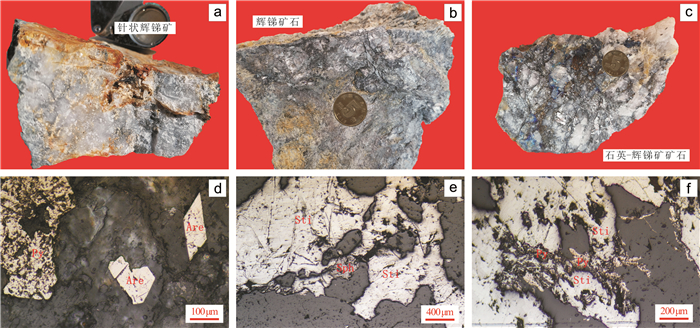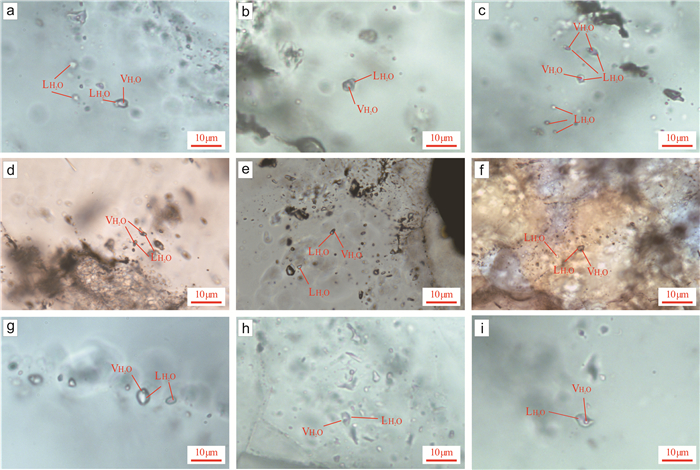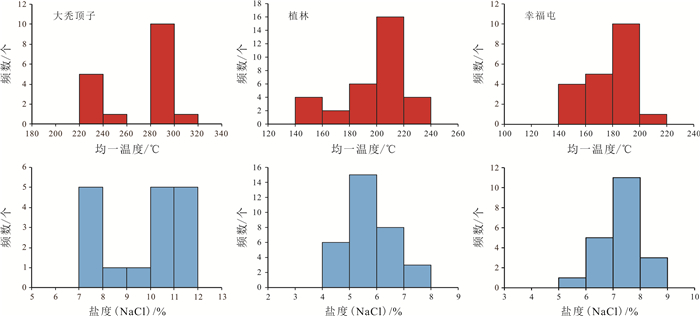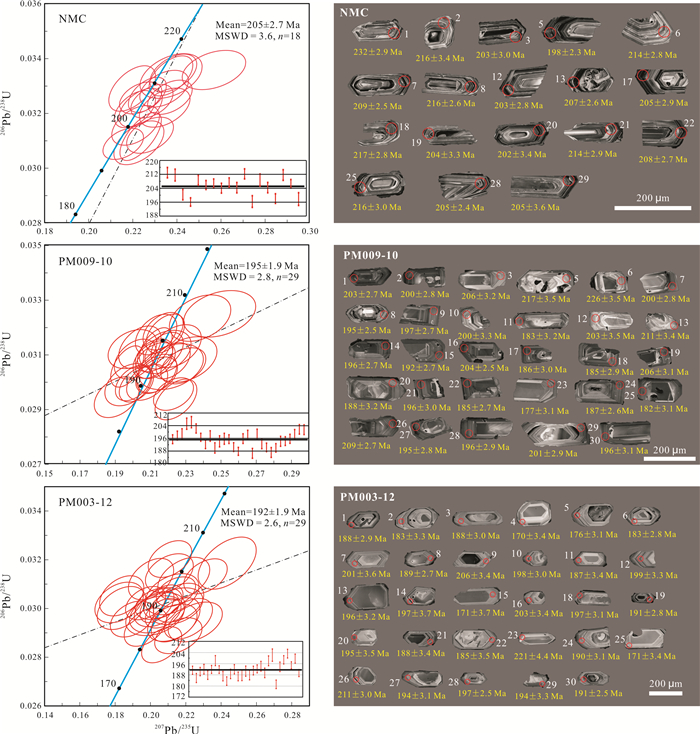ORE-FORMING FLUID CHARACTERISTICS AND IMPLICATION OF ANTIMONY DEPOSITS IN CENTRAL JILIN PROVINCE: A Case Study of Datudingzi, Zhilin and Xingfutun Antimony Deposits
-
摘要:
吉林中站地区分布着一系列金、锑、铜镍矿床, 成矿地质条件良好.对大秃顶子、幸福屯、植林3个锑矿床辉锑矿主成矿期石英流体包裹体进行显微测温研究和稳定同位素(H、O、S)分析, 结果表明, 流体包裹体主要发育有3种类型: Ⅰ型富液两相(LH2O+VH2O)包裹体, Ⅱ型纯液相(H2O)包裹体, Ⅲ型气相包裹体.包裹体均一温度范围为121.5~281.5℃, 盐度范围为3.39%~10.73%, 估算密度范围为0.833~0.985 g/cm3, 成矿流体为中低温、低盐度、低密度.H-O同位素组成特征显示, δ18O变化范围为15.71‰~18.28‰, δD变化范围为-111.1‰~-83.8‰, 成矿流体主要是岩浆热液, 后期有大气降水加入.黄铁矿的δ34S范围在-8.25‰~-3.86‰, 辉锑矿的δ34S范围在-8.18‰~-7.67‰, δ34S值范围较为集中, 明显区别于岩浆硫, 成矿物质主要来源于地壳.锆石U-Pb测年结果显示, 区内侵入岩的结晶年龄为205±2.7 Ma、192±1.9 Ma、195±1.9 Ma.锑矿床形成与岩浆热液联系密切, 矿床成矿时代为晚三世-早侏罗世.吉林中部锑矿床成因类型为浅成中低温热液型矿床.
Abstract:A series of gold, antimony and copper-nickel deposits are distributed in central Jilin Province with favorable metallogenic geological conditions. The study of microscopic temperature measurement and stable isotopes(H, O and S) for the quartz fluid inclusions in the major metallogenic period of stibnite in Datudingzi, Xingfutun and Zhilin antimony deposits shows that there are three main types of fluid inclusions including Type-Ⅰ of liquid-rich two-phase(LH2O+VH2O) inclusion, Type-Ⅱ of pure liquid phase(H2O) inclusion, and Type-Ⅲ of gas-phase inclusion, with the homogenization temperature of 121.5-281.5℃, salinity of 3.39%-10.73%, and estimated density of 0.833-0.985 g/cm3. The ore-forming fluid is characterized by low-medium temperature, low salinity and low density. The H-O isotopic composition characteristics show that δ18O is 15.71‰-18.28‰, and δD from -111.1‰ to -83.8‰. The ore-forming fluid is dominated by magmatic hydrothermal fluid, mixed with later atmospheric precipitation. The δ34S of pyrite ranges from -8.25‰ to -3.86‰, and that of stibnite from -8.18‰ to -7.67‰. The range of δ34S values is relatively concentrated, obviously different from magmatic sulfur. The metallogenic materials are mainly derived from the crust. The zircon U-Pb dating results reveal that the crystallization ages of the intrusive rocks are 205±2.7 Ma, 192±1.9 Ma and 195±1.9 Ma respectively. The formation of antimony deposit is closely related to magmatic hydrothermal fluid, aged in Late Triassic-Early Jurassic. The antimony deposits in central Jilin Province are of epithermal-mesothermal type genetically.
-
Key words:
- antimony deposit /
- fluid inclusion /
- stable isotope /
- metallogenic age /
- genesis of deposit /
- Jilin Province
-

-
表 1 流体包裹体测温及盐度计算结果
Table 1. Temperature measurement and salinity calculation of fluid inclusions
样品号 主矿物 数量 均一温度/℃ 盐度/%,NaCl当量 来源 范围 平均值 范围 平均值 21DTDZ1 石英 6 268.7~281.5 274.80 9.86~10.73 10.38 本文 21DTDZ2 石英 5 268.8~280.0 275.66 8.95~9.73 9.31 本文 21DTDZ3 石英 6 200.5~220.8 211.38 6.16~7.31 6.69 本文 21ZSC-1 石英 10 121.5~191.7 159.42 3.71~6.16 5.00 本文 21ZSC-2 石英 6 158.9~191.5 175.97 3.87~5.26 4.60 本文 21ZSC-3 石英 6 175.1~210.2 196.98 3.39~5.71 4.66 本文 21ZSC-4 石英 10 174.5~195.4 186.82 3.87~6.01 4.97 本文 21XFT1 石英 10 139.8~173.5 159.48 4.96~6.59 5.86 本文 21XFT2 石英 10 133.5~180.6 157.39 5.41~7.73 6.65 本文 21ED-4 石英 8 247.3~268.6 259.4 5.71~7.02 6.37 未发表数据 21ED-8 石英 7 248.9~277.6 262.4 6.30~7.45 6.92 未发表数据 21ED-9 石英 10 238.5~270.1 257.1 6.16~7.45 6.79 未发表数据 表 2 锑矿床石英氢氧同位素组成
Table 2. Hydrogen and oxygen isotopic compositions of antimony deposits
样品号 δ18OSMOW/‰ δDOSMOW/‰ δOH2O/‰ 温度/℃ 来源 21DTDZ-1 16.04 -87.0 7.86 217 本文 21DTDZ-2 16.17 -88.5 7.99 217 本文 DTDZ-10H 15.71 -111.1 7.53 217 本文 ZSC-20H 18.28 -104.3 10.10 217 本文 ZSC-10H 17.61 -106.2 9.42 217 本文 21XFT-1 18.11 -86.2 9.93 217 本文 21XFT-2 17.75 -83.8 9.57 217 本文 21EDDZ-2 13.2 -94.0 5.04 217 未发表数据 21EDDZ-1 13.1 -95.5 4.96 217 未发表数据 表 3 锑矿床硫同位素组成
Table 3. Sulfur isotopic compositions of antimony deposit
样品号 测试矿物 δ34SV-CDT/‰ 来源 21DTDZ-1 黄铁矿 -3.86 本文 21DTDZ-2 黄铁矿 -4.21 本文 21DTDZ-3 辉锑矿 -7.67 本文 21DTDZ-4 辉锑矿 -7.76 本文 DTDZ-LE 黄铁矿 -5.41 本文 DTDZ-10H 黄铁矿 -5.34 本文 ZSC-20H 黄铁矿 -8.03 本文 ZSC-10H 黄铁矿 -8.25 本文 21XFT-3 辉锑矿 -8.18 本文 21XFT-4 辉锑矿 -7.90 本文 21EDDZ-1 黄铁矿 -2.69 未发表数据 -
[1] 周树亮, 王瀛, 金京杰, 等. 吉林中部地区大秃顶子金锑矿区发现中型金矿床的意义[J]. 吉林地质, 2016, 35(4): 41-45. doi: 10.3969/j.issn.1001-2427.2016.04.011
Zhou S L, Wang Y, Jin J J, et al. Significance of the discovery of midsize gold deposit in Datudingzi gold-antimony mining area of central region of Jilin Province[J]. Jilin Geology, 2016, 35(4): 41-45. doi: 10.3969/j.issn.1001-2427.2016.04.011
[2] 赵际新, 周阳, 荆振刚, 等. 桦甸市大秃顶子金矿床地质特征及找矿远景[J]. 吉林地质, 2018, 37(2): 22-29. doi: 10.3969/j.issn.1001-2427.2018.02.006
Zhao J X, Zhou Y, Jing Z G, et al. Geological features and prospect of Datudingzi gold deposit in Huadian City[J]. Jilin Geology, 2018, 37(2): 22-29. doi: 10.3969/j.issn.1001-2427.2018.02.006
[3] 李锦轶. 中国东北及邻区若干地质构造问题的新认识[J]. 地质论评, 1998, 44(4): 339-347. doi: 10.3321/j.issn:0371-5736.1998.04.002
Li J Y. Some new ideas on tectonics of NE China and its neighboring areas[J]. Geological Review, 1998, 44(4): 339-347. doi: 10.3321/j.issn:0371-5736.1998.04.002
[4] 张梅生, 彭向东, 孙晓猛. 中国东北区古生代构造古地理格局[J]. 辽宁地质, 1998(2): 91-96.
Zhang M S, Peng X D, Sun X M. The Paleozoic tectonic geographical pattern of Northeast China[J]. Liaoning Geology, 1998(2): 91-96.
[5] 吴福元, 曹林. 东北亚地区的若干重要基础地质问题[J]. 世界地质, 1999, 18(2): 1-13.
Wu F Y, Cao L. Some important problems of geology in northeastern Asia[J]. World Geology, 1999, 18(2): 1-13.
[6] 张铁安, 刘宇奇, 高洪岩, 等. 黑龙江Ⅰ级成矿单元——成矿域的最新划分[J]. 地质与资源, 2022, 31(2): 156-164. doi: 10.13686/j.cnki.dzyzy.2022.02.005
Zhang T A, Liu Y Q, Gao H Y, et al. The first-order metallogenic units in Heilongjiang Province: New division of metallogenic domain[J]. Geology and Resources, 2022, 31(2): 156-164. doi: 10.13686/j.cnki.dzyzy.2022.02.005
[7] 王义强, 吕建生, 杨言辰, 等. 吉林省二道甸子金矿控矿构造演化特征及控矿作用[J]. 地质力学学报, 1995, 1(3): 82-88. https://www.cnki.com.cn/Article/CJFDTOTAL-DZLX503.010.htm
Wang Y Q, Lv J S, Yang Y C, et al. Evolution of the ore-controlling structures of Erdaodianzi gold-deposit in Jilin Province[J]. Journal of Geomechanics, 1995, 1(3): 82-88. https://www.cnki.com.cn/Article/CJFDTOTAL-DZLX503.010.htm
[8] Hall D L, Sterner S M, Bodnar R J. Freezing point depression of NaCl-KCl-H2O solutions[J]. Economic Geology, 1988, 83(1): 197-202. doi: 10.2113/gsecongeo.83.1.197
[9] 邵洁涟. 金矿找矿矿物学[M]. 武汉: 中国地质大学出版社, 1988: 1-158.
Shao J L. Prospecting mineralogy of gold deposits[M]. Wuhan: China University of Geosciences Press, 1988: 1-158. (in Chinese)
[10] 孙丰月, 金巍, 李碧乐. 关于脉状热液金矿床成矿深度的思考[J]. 长春科技大学学报, 2000, 30(S1): 27-30.
Sun F Y, Jin W, Li B L. The metallogenic depth of vein hydrothermal gold deposits[J]. Journal of Changchun University of Science and Technology, 2000, 30(S1): 27-30. (in Chinese)
[11] Roedder E. Fluid inclusions[C]//Ribbe P H. Reviews in mineralogy. Washington DC: Mineralogical Society of America, 1984: 1-644.
[12] Wilkinson J J. Fluid inclusions in hydrothermal ore deposits[J]. Lithos, 2001, 55(1/4): 229-272.
[13] Clayton R N, O'Neil J R, Mayeda T K. Oxygen isotope exchange between quartz and water[J]. Journal of Geophysical Research, 1972, 77(17): 3057-3067. doi: 10.1029/JB077i017p03057
[14] 卢焕章, 范宏瑞, 倪培, 等. 流体包裹体[M]. 北京: 科学出版社, 2004: 1-487.
Lu H Z, Fan H R, Ni P, et al. Fluid inclusion[M]. Beijing: Science Press, 2004: 1-487. (in Chinese)
[15] Kelly W C, Rye R O. Geologic, fluid inclusion, and stable isotope studies of the tin-tungsten deposits of Panasqueira, Portugal[J]. Economic Geology, 1979, 74(8): 1721-1822. doi: 10.2113/gsecongeo.74.8.1721
[16] Hoefs J. Stable isotope geochemistry[M]. 4th ed. Berlin: Springer, 1997: 1-383.
[17] 张海洪. 辽北-吉中地区中生代岩浆事件及其对区域构造演化的制约[D]. 长春: 吉林大学, 2017.
Zhang H H. Mesozoic magmatic events in northern Liaoning and central Jilin provinces: Constraints on the regional tectonic evolution[D]. Changchun: Jilin University, 2017.
[18] 赵华伟, 李德洪, 臧兴运, 等. 吉中-延边地区燕山期岩浆作用与矿床成矿系列研究[J]. 地质学报, 2020, 94(1): 241-254. doi: 10.19762/j.cnki.dizhixuebao.2020119
Zhao H W, Li D H, Zang X Y, et al. A study of magmatism and ore deposit series of Yanshanian magmatism in the central Jilin-Yanbian area[J]. Acta Geologica Sinica, 2020, 94(1): 241-254. doi: 10.19762/j.cnki.dizhixuebao.2020119
[19] 吴尚全. 吉林省二道甸子金矿床同位素地质学及成矿物质来源研究[J]. 黄金, 1995, 16(8): 5-9. https://www.cnki.com.cn/Article/CJFDTOTAL-HJZZ508.001.htm
Wu S Q. Study on isotopic geology and source of ore-forming materials of Er-dao-dian-zi gold deposit, Jilin Province, China[J]. Gold, 1995, 16(8): 5-9. https://www.cnki.com.cn/Article/CJFDTOTAL-HJZZ508.001.htm
[20] 中国有色金属工业总公司地质勘查总局. 中国锑矿地质及矿床实例[M]. 北京: 矿产地质研究所, 1996: 1-224.
General Administration of Geological Exploration of China Nonferrous Metals Industry Corporation. Geology and examples of antimony deposits in China[M]. Beijing: Beijing Institute of Mineral Geology, 1996: 1-224. (in Chinese)
[21] 赵一鸣, 吴良士, 白鸽, 等. 中国主要金属矿床成矿规律[M]. 北京: 地质出版社, 2004: 194-221.
Zhao Y M, Wu L S, Bai G, et al. Metallogeny of the major metallic ore deposits in China[M]. Beijing: Geological Publishing House, 2004: 194-221.
[22] 陈毓川, 王登红, 李厚民, 等. 重要矿产预测类型划分方案[M]. 北京: 地质出版社, 2010: 1-222.
Chen Y C, Wang D H, Li H M, et al. Division for prospection types of important mineral resources in China[M]. Beijing: Geological Publishing House, 2010: 194-221. (in Chinese)
[23] 王永磊, 徐珏, 张长青, 等. 中国锑矿成矿规律概要[J]. 地质学报, 2014, 88(12): 2208-2215. https://www.cnki.com.cn/Article/CJFDTOTAL-DZXE201412005.htm
Wang Y L, Xu J, Zhang C Q, et al. Summary of metallogenic regularities of antimony deposits in China[J]. Acta Geologica Sinica, 2014, 88(12): 2208-2215. https://www.cnki.com.cn/Article/CJFDTOTAL-DZXE201412005.htm
-



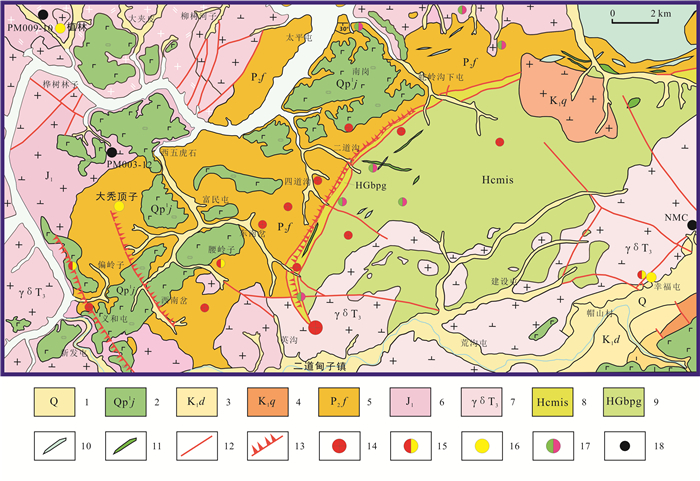
 下载:
下载:
